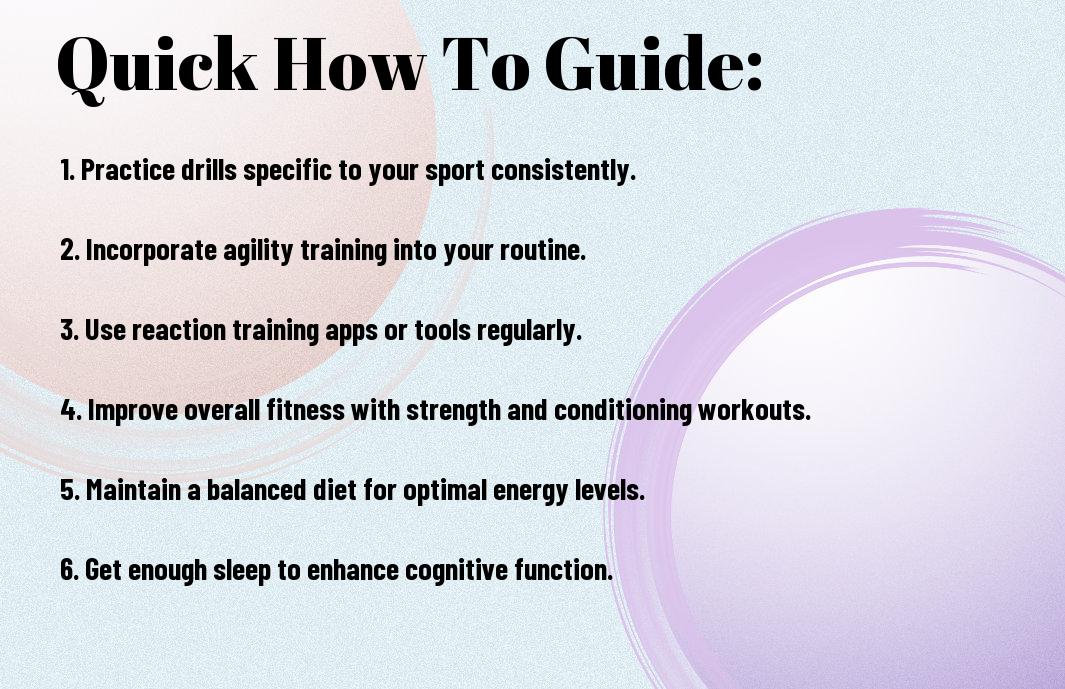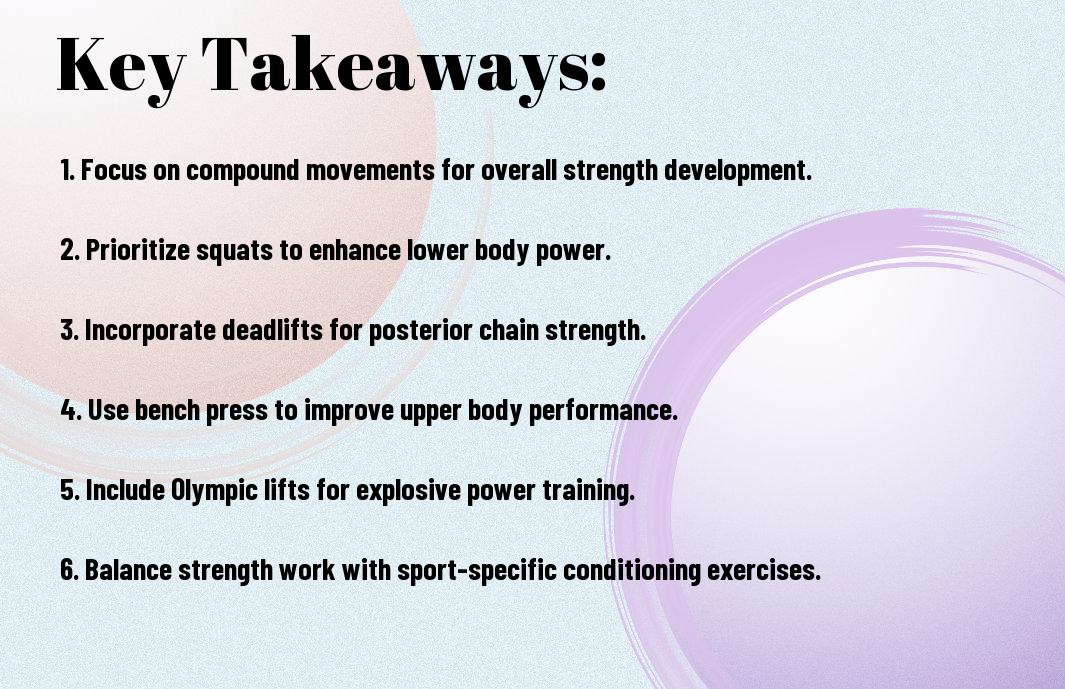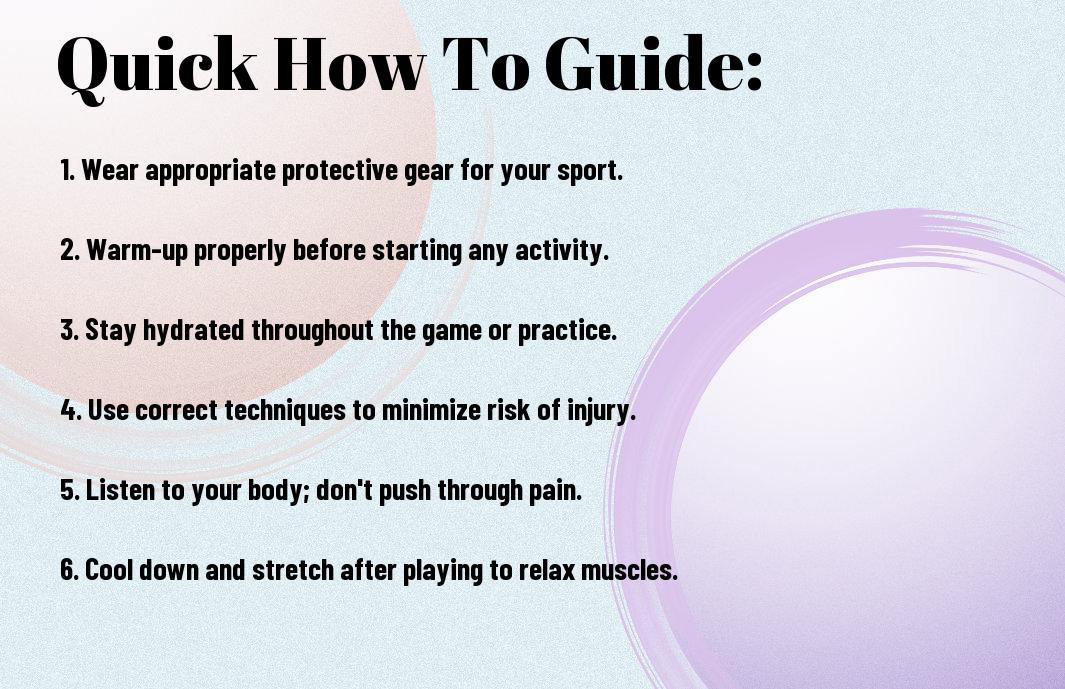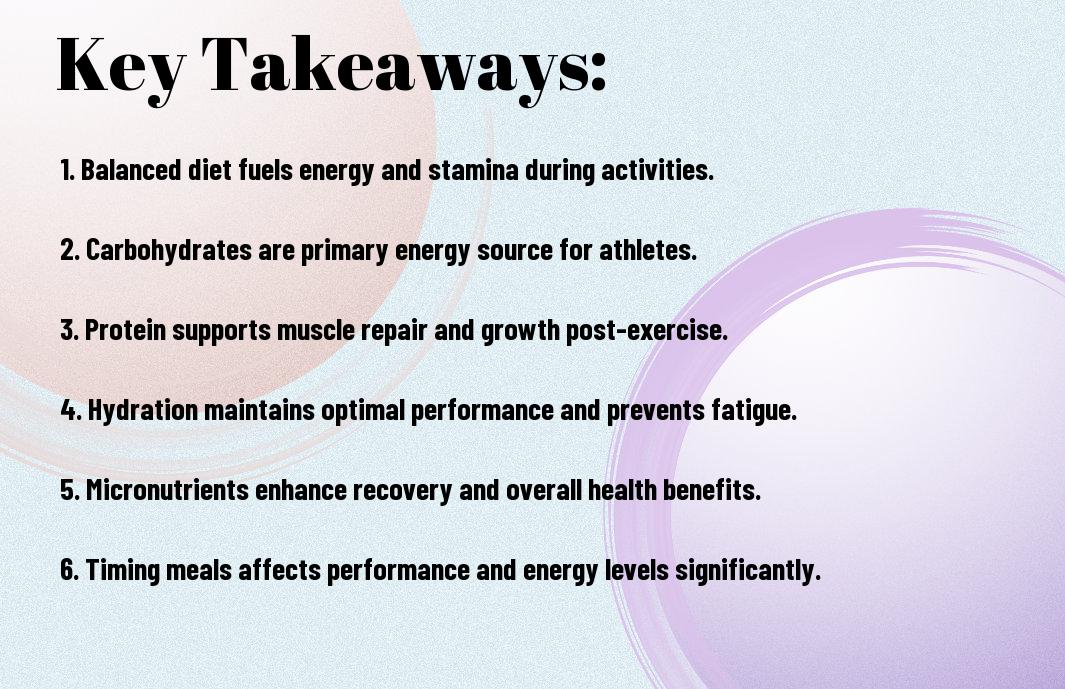Many athletes and fitness enthusiasts aim to enhance their endurance levels, and choosing the right sport can significantly impact your performance. By participating in specific sports, you can develop your stamina and cardiovascular fitness effectively. In this post, you’ll discover the top five sports that are perfect for building endurance, allowing you to push your limits and achieve your fitness goals. Whether you’re a beginner or looking to elevate your training regimen, these activities can help you boost your endurance and overall athleticism.

Key Takeaways:
- Running: A fundamental endurance sport that enhances cardiovascular health and endurance capacity.
- Cycling: Excellent for building leg strength and improving stamina while being low-impact on joints.
- Swimming: Engages multiple muscle groups and boosts overall conditioning with minimal risk of injury.
- Rowing: Combines strength and endurance, offering a full-body workout that challenges both muscles and lungs.
- Cross-Country Skiing: A highly effective endurance activity that builds aerobic fitness and upper/lower body strength simultaneously.
Running
For anyone looking to build endurance, running is one of the most accessible and effective sports. It requires minimal equipment and can be done almost anywhere. From sprinting on a track to long-distance trail runs, there are various styles to suit your preferences and fitness levels. Consistent running not only enhances cardiovascular health but also strengthens your muscles, making it a holistic endurance-building activity.
Benefits of Running for Endurance
Besides improving your heart health, running significantly boosts your stamina and lung capacity. As you incorporate longer distances and varied paces, you increase your body’s efficiency in using oxygen, thus enhancing your endurance over time. Additionally, running helps in mental resilience, enabling you to push through physical barriers you may encounter.
Training Techniques
On your journey to build endurance through running, it’s beneficial to implement a structured training plan. Incorporating interval training, long runs, and tempo runs can create a balanced routine that maximizes your endurance gains.
For instance, interval training involves alternating between high-intensity bursts and recovery periods, allowing you to improve both speed and endurance. Long runs are vital as they help you gradually increase your distance, enhancing your stamina. Tempo runs, which are performed at a challenging but sustainable pace, teach your body to maintain speed over longer durations. By mixing these techniques, you can develop a well-rounded approach to building your running endurance effectively.
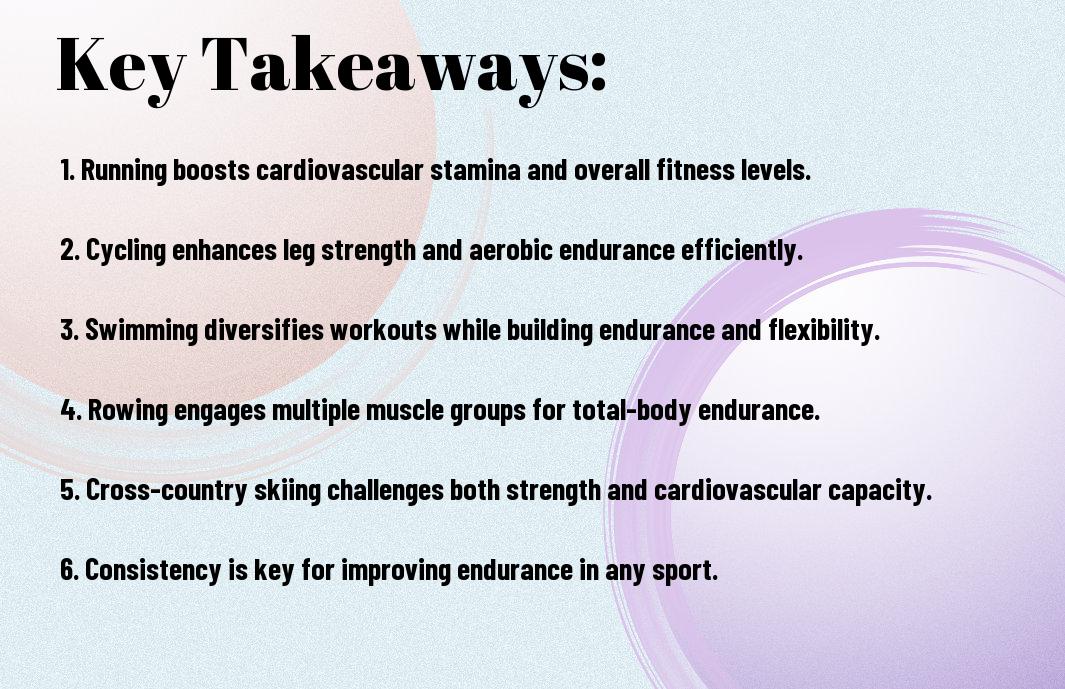
Cycling
Now, cycling is a fantastic way to build endurance, allowing you to enjoy the outdoors while boosting your physical fitness. Whether you prefer leisurely rides or intense cycling sessions, the rhythmic pedaling helps develop cardiovascular strength, muscle tone, and stamina. Engaging in cycling regularly can lead to significant improvements in your overall endurance, making it an excellent choice for athletes and fitness enthusiasts alike.
Types of Cycling for Endurance
Below is a breakdown of cycling types ideal for building endurance:
| Type | Description |
| Road Cycling | Fast-paced riding on paved roads, great for distance. |
| Mountain Biking | Riding on rough terrains, builds strength and endurance. |
| Track Cycling | Cycling on a track, focuses on speed and technique. |
| Cyclo-Cross | A mix of road and mountain biking, excellent for stamina. |
| Indoor Cycling | Stationary cycling for controlled workouts and endurance. |
Knowing the type of cycling you enjoy will help you choose the right endurance-building approach.
Key Training Tips
Endurance training in cycling requires a structured approach to help maximize your performance and stamina. Consistency is key, and incorporating various ride lengths and intensities can be very beneficial. Here are some necessary training tips:
- Start with shorter rides and gradually increase duration.
- Incorporate intervals to challenge your stamina.
- Prioritize recovery to prevent overtraining.
- Stay hydrated and fuel properly for longer rides.
After building your foundation, you can fine-tune your training to reach your endurance goals.
Consequently, incorporating a mix of long, steady rides and interval training will help you optimize your endurance. It’s necessary to focus on building a strong base before increasing intensity. Here are more key aspects to enhance your training:
- Track your progress to stay motivated.
- Join group rides for social interaction and challenge.
- Experiment with a variety of terrains to keep things interesting.
- Consider cross-training for overall fitness.
After you implement these training tips, you will notice significant improvements in your cycling endurance and overall performance.
Swimming
Unlike many other sports, swimming is a low-impact activity that engages multiple muscle groups simultaneously. This makes it an effective way to build endurance without putting excessive strain on your joints. Whether you’re participating in freestyle, breaststroke, or any other stroke, swimming can enhance your aerobic capacity, improve lung function, and promote overall fitness. Plus, it’s a refreshing way to enjoy your workout while immersing yourself in water.
Endurance Challenges in Swimming
Around the pool or open water, swimmers often face specific endurance challenges such as maintaining a consistent pace and overcoming fatigue during long-distance swims. You might find that the need to breathe rhythmically can disrupt your flow, impacting your overall performance. Additionally, the resistance of water requires more energy than you might expect, which can lead to early exhaustion. Staying aware of these factors will help you plan your training effectively.
Techniques to Increase Stamina
Along with building your swimming endurance, incorporating various techniques can make a significant difference in your stamina. You should focus on interval training, where you alternate between high-intensity laps and rest periods, allowing your body to adapt to demanding situations. Additionally, practicing proper breathing techniques can enhance your efficiency and reduce fatigue during lengthy swims. Regularly setting distance goals will also challenge you and keep you motivated to improve.
With interval training, you can structure your swims to include short bursts of speed followed by slower recovery periods, effectively boosting your endurance over time. Implementing drills that focus on your technique will help reduce energy expenditure, enabling you to swim longer distances with less fatigue. Gradually increasing your swim distances each week can also foster adaptation and growth in your stamina. Always listen to your body, ensuring you avoid overexertion as you work towards your endurance goals.
Rowing
To build endurance effectively, rowing offers a dynamic mix of aerobic and anaerobic exercise that enhances your stamina. This low-impact sport engages multiple muscle groups, making it an excellent choice for increasing overall cardiovascular capacity. Whether you’re on the water or using a rowing machine, you’ll find that regular sessions not only improve your endurance but also boost your strength and coordination.
Full-Body Workout for Endurance
Below the surface, rowing activates a range of muscle groups, including your legs, core, back, and arms. This full-body workout not only burns calories but also builds muscular endurance, allowing you to row longer distances with ease. The rhythmic motion of rowing also promotes good posture and strengthens your overall body mechanics, enhancing your physical resilience.
Developing a Rowing Routine
Rowing provides a unique opportunity for you to develop a consistent routine that layers endurance training with skill development. Start by setting realistic goals based on your current fitness level, gradually increasing the duration and intensity of your sessions as you progress. Aim for a mix of steady-state rows and interval training to challenge your body, ensuring your routine remains fresh and engaging over time.
Understanding your individual fitness level is vital in crafting a rowing routine that suits your needs. Start with shorter distances and lower intensities, then gradually increase as your endurance improves. You can incorporate various workouts, such as steady-state rows for aerobic endurance and high-intensity intervals to boost anaerobic capacity. Tracking your progress will help motivate you as you observe your advancements in endurance and strength over time.
Hiking
Many outdoor enthusiasts know that hiking is a fantastic way to build endurance and connect with nature. It involves not only physical exertion but also mental resilience, making it an ideal choice for those seeking to improve their stamina. If you’re curious about what the top endurance sports are, hiking should definitely be on your list.
Improving Endurance Through Hiking
On your hiking journey, gradually increasing the difficulty and duration of your hikes can significantly enhance your endurance. Start with shorter trails and progressively tackle challenging terrains or longer distances. Incorporating hiking into your regular routine can help develop your cardiovascular fitness and leg strength, which are crucial for prolonged physical activity.
Safety Tips for Long Hikes
Around any hiking adventure, it’s important to prioritize your safety, especially when hiking long distances. Here are some tips to consider before you set out:
- Plan your route ahead of time and inform someone about your plans.
- Carry sufficient water and snacks to maintain your energy levels.
- Wear appropriate footwear and clothing for changing weather conditions.
- Take regular breaks to avoid fatigue.
Perceiving potential hazards and being prepared can make your hiking experience both enjoyable and safe.
Endurance in hiking not only depends on physical conditioning but also on mental preparedness. When preparing for long hikes, consider these additional safety tips:
- Utilize maps or GPS for navigation to avoid getting lost.
- Check weather forecasts before your hike to avoid unexpected conditions.
- Start early in the day to maximize daylight hours.
- Be aware of the wildlife in the area and know how to react.
Perceiving these factors can greatly enhance both your safety and your enjoyment while hiking.
Final Words
Upon reflecting, engaging in the top sports for building endurance can significantly enhance your physical fitness and overall well-being. By participating in activities like running, cycling, swimming, rowing, or cross-country skiing, you not only improve your stamina but also promote cardiovascular health. Incorporating these sports into your routine allows you to challenge yourself and track your progress over time. Embrace the journey of endurance training, as it fosters resilience both in sports and in life, ultimately helping you reach your personal fitness goals with determination and consistency.
Q: What are the top sports that help in building endurance?
A: The top five sports known for enhancing endurance are long-distance running, cycling, swimming, rowing, and cross-country skiing. Each of these sports requires sustained physical activity, allowing athletes to develop higher aerobic capacity and stamina, which are necessary components of endurance.
Q: How do these sports specifically contribute to improving endurance?
A: Endurance in sports is primarily developed through prolonged physical exertion. Long-distance running involves continuous pacing over extended distances, which enhances cardiovascular health. Cycling provides a low-impact option that builds stamina without stressing the joints. Swimming incorporates various muscle groups, promoting overall endurance while still being easy on the body. Rowing combines strength and cardiovascular training, as it requires both upper and lower body coordination. Lastly, cross-country skiing demands constant movement and engages multiple muscle groups, boosting endurance and aerobic fitness.
Q: Are there any specific training tips to improve endurance in these sports?
A: To enhance endurance in these sports, it’s beneficial to include interval training, which alternates between high-intensity bursts and lower-intensity recovery periods. Gradually increasing the distance or duration of workouts can also help build stamina. In addition, incorporating strength training can support muscle endurance and improve overall performance. Lastly, proper nutrition and hydration are vital to ensure the body can sustain longer durations of exercise without fatigue.
